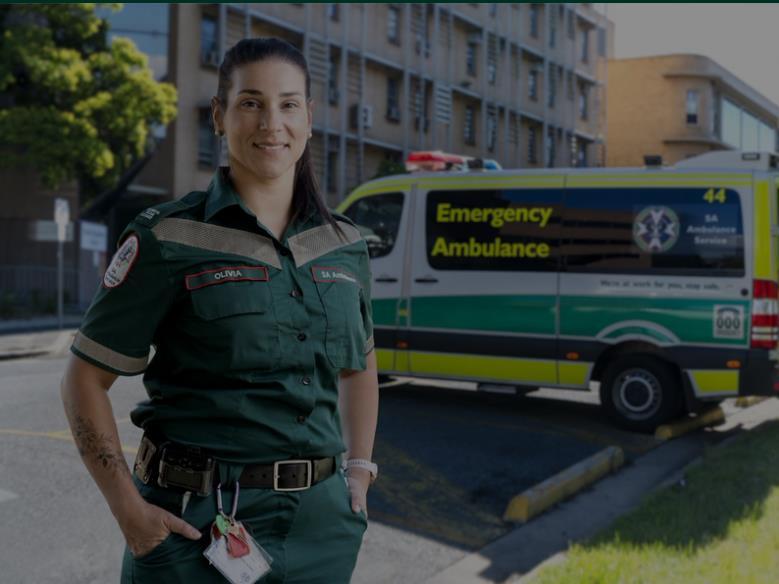CAA Women in Ambulance Survey
2018 marked an important milestone for the CAA and women in ambulance by seeing the establishment of the CAA Women in Leadership working group. The group provides a forum for women leaders in the ambulance sector being given the opportunity to exchange knowledge and effect changes in the sector.
The working group works to address challenges and adversities by encouraging leadership development and mentoring, creating networking opportunities, facilitating research and data collections to better understand workforce and environment.
2020 saw the launch of Women in Ambulance campaign designed to highlight successful and hardworking women in ambulance services across the CAA member services.
In July 2020 the first Women in Leadership Survey was launched to hear from women in the ambulance sector directly. Over 1,000 women from the ten Australian and New Zealand ambulance services answered the call to provide feedback to what they feel were the most important skills and opportunities to grow their careers and what the challenges are that might be preventing them reaching the top leadership roles
In this report the survey was renamed to Women in Ambulance Survey to better identify the objective of the survey: to hear from women in ambulance. The 2022 report includes data from the 2022 survey and had over 1,200 responses.
These results will provide great insights and direction for the CAA Women in Leadership working group going forward.
Page 4 of 29
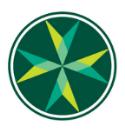
Survey Results
The survey was open to all female staff members across Australian, New Zealand and Papua New Guinean ambulance services in July 2022. We received a total of 1,230 responses with 36% from Ambulance Victoria, 25% from New South Wales Ambulance, 3% St John Ambulance Papua New Guinea, 8% Hato Hone St John and 1% Wellington Free Ambulance Over half (52%) of the respondents are aged between 30 – 49 years and 38% of respondents have been with the service less than five years.
Response Location



Page 5 of 29
Years of Service
Age

In 2022, the majority (81%) of respondents are employed on full-time or flexible full-time basis, with 12% part-time or flexible part time, 4% volunteers and 3% casual employees. This is similar to the 2020 survey results, with the majority (83%) of respondents working full-time, 10% part-time, 5% volunteer and 2% casual.
Employment Type

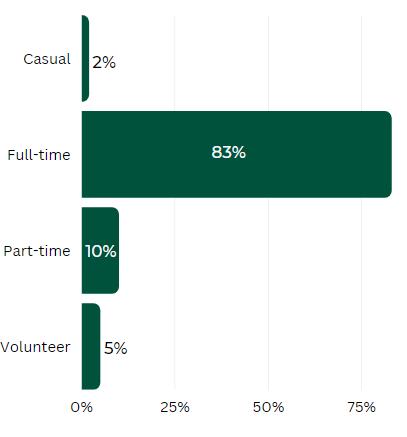
The CAA ran a workforce and gender data collection in 2022 and across the Australian, New Zealand and Papua New Guinean Ambulance services women represent 53% of the workforce, a 3% increase from 2020. When we look at the breakdown of job roles, we can see the percentage decrease to 39% in executive roles, this is an increase from the 37% reported in 2020.
Gender

Page 6 of 29
2022 Survey Results 2020 Survey Results

Employment Category
Medical Officers/Medical Director
Management – Operational Managers
Executives
Employment catergory
Clinical Support / Infrastructure Support /…
Patient transport officers
Qualified ambulance officers / Students and base…
Doctors / Nurses / Psychologists / Pharmarcist
Supervisors
Volunteers & First responders
Calltakers / Dispatchers / Other
Marketing / Finance / Human Resource /…
Level of Education
In 2022, almost half (48%) of responders hold a bachelor’s degree and 9% hold a masters or doctorate degree. This is an increase from 2020 where 41% of staff held a bachelor’s degree, and a decrease from the 13% of staff with a masters or doctorate degree.
Level of Education 2022 Survey Results
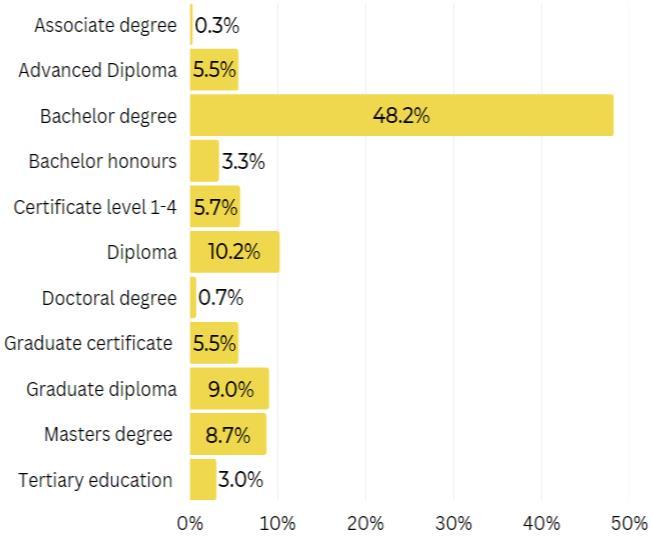

Page 7 of 29
2020
69.5% 70.2% 59.9% 48.8% 47.2% 48.1% 45.3% 43.3% 38.8% 37.8% 26.9% 30.5% 29.8% 40.1% 51.2% 52.8% 51.9% 54.7% 56.7% 61.2% 62.2% 73.1% 0% 10% 20% 30% 40% 50% 60% 70% 80% 90% 100%
Survey Results
Percentage
Female Male

Position in Organisation
In 2022, majority of responders are paramedics (49%), followed by clinical operations personnel (10%), and managers (9%) In 2020, majority of respondents were paramedics (43%), followed by managers (12%), and volunteers (7%).
2022 Survey Results
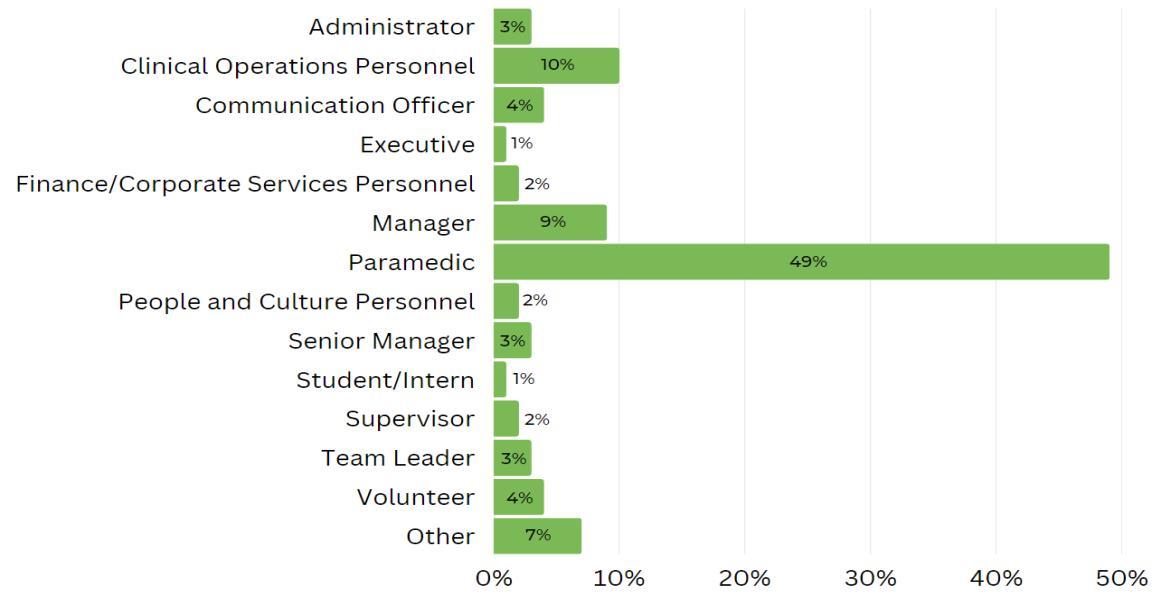
2020 Survey Results
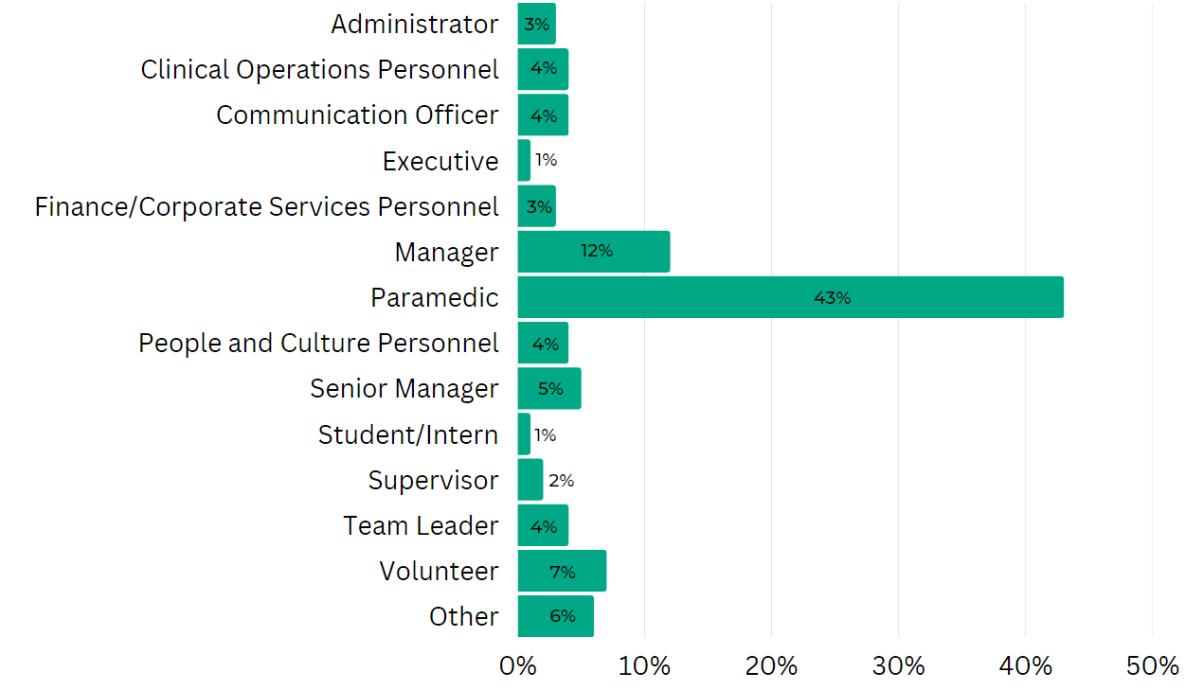
Page 8 of 29

Leadership
When asked about what leadership means to them, the respondents had the opportunity to provide open ended responses, providing very insightful information.
“Providingdirection, inspiration,andchange throughmeaningfuland intentionalaction.”
“Displayofopenandhonest opinionthatisprofessional eitherthrough communication,example,or workoutput. Standingby convictionsandensuring actionsareclear,butalways respectfulandtruenatured”
“Inspiring,communicating, organizing,demonstrating vision,settingandreaching goals.Supportingstaff, mentoring,coachingand workingasacentralpartofa team.Ahugepartof leadershipisaboutbringing theteamtogethertowork towardsasharedvision.”
“Guiding,supportingand empoweringyourstafftodo theirjobstothebestoftheir ability,andproviding opportunitiesforthemto continuetolearn,growand stayinterestedandengaged”
“Developingotherstowards fulfillingtheirpotential, workingtowardsstrategic goals,earningthetrustof yourteam,and100% honesty,integrity,and fairness.Allowingothersto lead.Notmicro-managing.”
“Someonethatleadsby example,whoiswillingtobe proactive,whostrivestobe better,excellenceand encouragesthosearound themtoimprovethemselves andguidethem.”
“Harnessingtheskills,aswell asencouragingand supportinggrowthinyour employees”
“Leadershipmeansleadingby example.Itisbeingarole modelforthebehavioursand valuesoftheorganisation.”
“Leadersshouldnurturetheir teamstoallowthemtoreach theirfullpotential.”
“Workingtogetherwithyour teamtoreachacommongoal. Beinginvolvedinthetaskor change,ratherthandictating whatisrequiredtobedone andnotbeinginvolved.”
“Encouragingbehavioursthat promoteahealthyandsafe workspace,beingagood communicator,beingableto uniteemployeestosharethe values,visionandgoalsofthe organisationandtohave themunderstandthatthey arevaluedandhavea purpose.”
“Leadershipmeanstheability toguideandmentorothers byenablingthemtoachieve thegoalsoftheorganisation andtheirownpersonal professionalgoalsina positive,encouraging,and supportivemanner.”
Page 9 of 29

Looking at what skills women in the ambulance sector value most in a leader, rated top was Trustworthiness (863), followed by Communication (853) and Accountability (728). This is consistent with the 2020 survey results.
Respondents were able to select multiple answers to this question.

Page 10 of 29

Leadership & You
This section explored how women see themselves as leaders, how they pursue growing opportunities, their confidence in exercising authority, confidence in stepping up to senior roles and what are the challenges in progressing their careers.
58% of respondents agreed or strongly agreed they are a leader in their organisation independent of their job title. In the 2020 survey, 66% of respondents agreed or strongly agreed they are leaders in their organisation.
56% respondents agreed or strongly agreed that they actively pursue learning and professional growing opportunities, a decrease from the 87% of respondents in the 2020 survey. 68% agreed or strongly agreed that they are comfortable exercising their own authority, a decrease from the 73% of respondents in the 2020 survey. 56% of respondents agreed or strongly agreed they feel confident to advance to a more senior level, this is an increase from the 49% reported in the 2020 survey.
Independent of my job title, I am a leader in my organisation.
I actively pursue learning and professional growth opportunities.
I am comfortable exercising my own authority.
On a personal level, do you feel confident that you can advance to more senior levels of leadership?

Page 11 of 29

This question offered respondents an option to select multiple answers. The survey showed that women most commonly pursue their learning and professional growth through education, with a total of 757 responses. This was followed by mentoring (527), networking (388), research (337) and peer coaching (332) 93 ‘other’ responses, survey respondents offered a variety of ways, summarised below, how they actively pursue their learning and professional growth, with the theme that these pursuits are undertaken in their personal time.
These results are consistent with those reported in the 2020 survey, 715 respondents reported education as how they pursue their learning and professional growth, followed by mentoring (490), networking (389), research (347), peer coaching (315), and other (78).
How do you pursue your learning and professional growth?
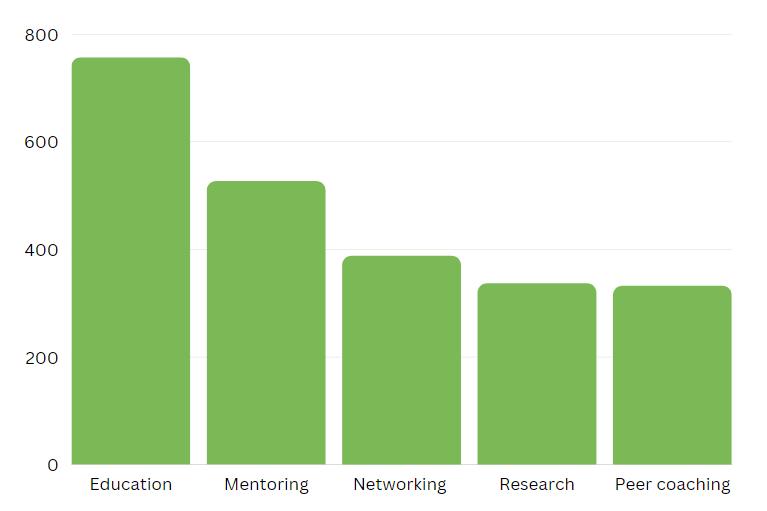
Challenges
Looking at challenges women face to grow their careers; the survey offered a choice of multiple answers as well as asking respondents to write down their experience and thoughts.
With 466 responses, the biggest challenge is a lack of opportunities for promotion, followed by unconscious (or conscious) bias (397), confidence (328) and location of opportunity (326) These challenges were also the top responses in the 2020 survey.
1. Having opportunities for promotion
2. Dealing with unconscious (or conscious) bias - including unfair perceptions that others have of their abilities and potential as leaders.
3. Location of opportunity - opportunities only being in city centres or lack of flexible working opportunities.
Page 12 of 29

4. Women ’s own mindset - internalised feelings of self-doubt, lacking confidence to challenge the status quo.
5. Age - either due to the presumption that a person is not suitable for a role due to being of “child bearing age” or is close to retirement.
6. Female role models - either due to having minimal female role models, limited access to networks of women, or even from experiencing negative behaviour by women who have been successful in attaining their own goals, but who for various reasons do not mentor, advocate for or support other women in their careers.
7. Multiple role conflict - encompassing parental and other carer responsibilities and the many associated issues i.e. returning to work after parental leave, limited access and expense of child care, emotional and physical burden.
What are the biggest challenges faced when pursuing your career goals?
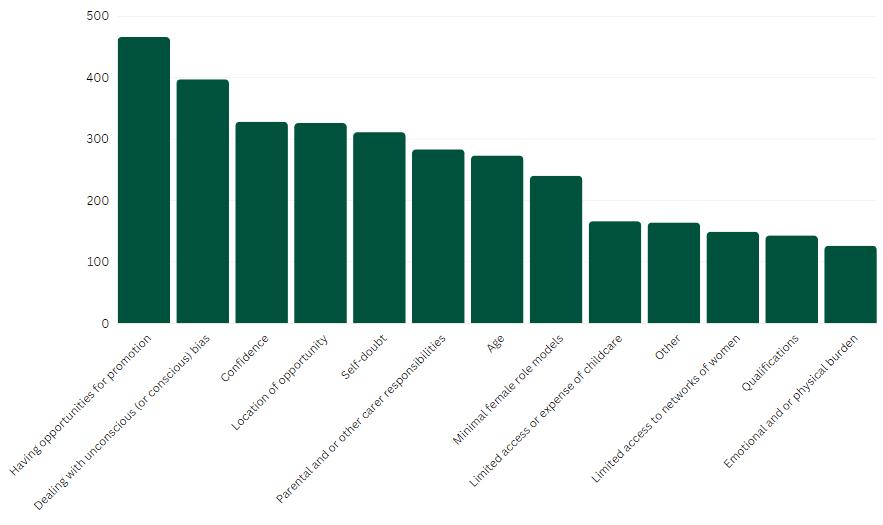
Page 13 of 29

Leadership & Your organisation
What are the current leadership development opportunities in your organisation?
What would you like to see in the way of leadership development opportunities in your organisation?

There were 895 comments to the question, “What are the current leadership development opportunities in your organisation?” The general theme was that there aren’t any opportunities, or there are limited resources of time and funding for this opportunity to be taken up.
There were over 895 comments to the question, “What would you like to see in the way of leadership development opportunities in your organisation?”. The general theme was that respondents would like to see all options made available as opportunities and of the opportunities that are currently available to also be available in a flexible approach e.g., for staff working parttime.
These responses are consistent with the 2020 survey.
Only 18% of survey respondents agreed or strongly agreed that their organisation recognises and rewards leadership, a decrease from the 23% reported in the 2020 survey.
Page 14 of 29

Your organisation recognises and rewards leadership:

Research by Wei and Yazdanifard have shown that for every piece of criticism that an employee receives, whether constructive or not, six pieces of positive reinforcement are needed to counteract it.
Employees that don’t feel recognised or appreciated are less loyal to their employers than their appreciated team members, whereas employees that feel recognised are more engaged, leading them to be more productive.
Reward and recognition needs to be part of a company’s culture – but it won’t get there without leadership providing a framework for reward and recognition and encouraging their employees to be part of it.
Employers need to provide their managers and employees with the tools to reward and recognise each other, then actively encourage and reinforce positive behaviours using those tools until it becomes a habit.
L. Wei and R. Yazdanifard, "The impact of Positive Reinforcement on Employees’ Performance in Organizations," American Journal of Industrial and Business Management, Vol. 4 No. 1, 2014, pp. 9-12. doi: 10.4236/ajibm.2014.41002.
When asked about what in their opinion impedes leadership development training in their organisations the survey offered respondents' open-ended responses.
Below are some examples of their feedback.
“Time.There'stoomuchwork todothatnooneseemsto havethetimetoinvestinthis.”
“Operationalpressure.Inthis industry,itishinderedbythe abilitytostudywithshift work”
“Theselectioncriteriaand limitedopportunitiesinrural areas,outsideofthemetro region.”
Page 15 of 29
“Lackofopportunityincertain areas.Especiallyforsingle motherswhocannotleave theircurrentworkingareafor opportunities.Notenough offeredopportunities providedbytheservice.”
“Accesstotimewithaperson whoissuitablyqualifiedand notoverworkedsothatthey cantrainandmentoryou appropriately”
“Timewouldbethemain factorforyoungerwomen, especiallyvolunteerswhoare alreadyjugglingworkand familycommitmentsto volunteerinthefirstplace”

“BAUhasbeenextremely busy,manyvacancieshavenot beenfilledandstaffhavebeen expectedtoassumethetasks fortheirsamepay,leavingno availabletimetooffer,attend oreventhinkabouttraining.”
“Workloads.Iftherewasa program,equityinaccess shouldbeconsidered. Increasedcommunication betweenstateandregionsalso required.”
“Lackofopportunitiesand varietyinleadershiproles”
“Howit’sdelivered,flexibility, location.”
Survey participants were asked to think about the Latest Job Advertisement they saw. The remaining questions were not asked in the 2020 survey.
Have you applied for a leadership position in the last 12 months?
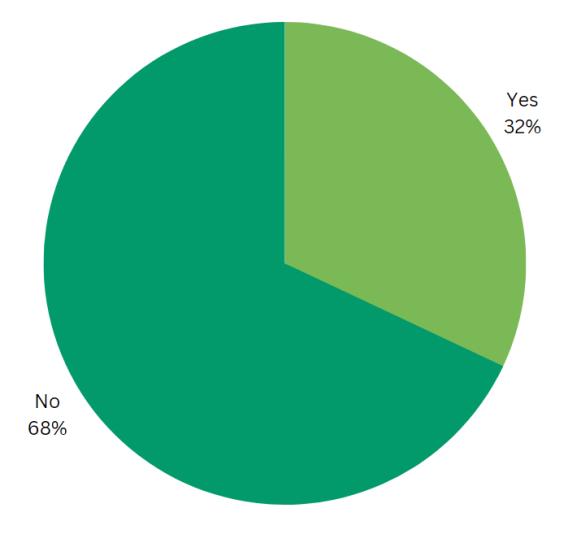
Page 16 of 29

Can you share the process and any thoughts or feelings of your latest application.
“Needingendorsementfrom ourdirectlinemanageronly, givestomuchauthoritytoone personchoosingcanprogress. Noaccountabilityfortheir personaldecisionisrequired. Createsajobs/opportunitiesfor matesculture.”
“Transparentandwell-rounded merit-basedprocess;equal opportunitytoapplicants; adjustmentstoStatementof Dutiestobroadenapplicant pool(ieremovalofparamed qualasessentialrequirement).“
“DespitebeingtoldImetalloftheessential criteria,Iwasnotprovidedwithanopportunity tohaveaninterview. IwasalsoadvisedthatI neededtogetsomeexperienceoutsideofthe industrytobemorecompetitiveifIwantedto progressmycareer. Thiswasdespitehaving completedaGradDip.”
“Iappliedformycurrentrole whichisapromotion.The recruitmentprocesswasrunby anexternalrecruitment consultancywhichmeansthere wasless(perceivedoractual) biasintherecruitmentprocess”
“Standardinternalpositionapplicationprocess. Wasn'toptimisticduetoworking0.5-0.6FTE,but hadalltheprerequisitesandhadalreadydone therolebeforeitwasformalisedintoaposition. Managerchosenottoapprove/putforward applicationbecauseparttime.”
Can you share any thoughts or feelings as to what stopped you from applying for the position? There were 600 open ended responses to this question, some of the feedback included.
”Location-90%ifourleadership rolestheyarebasedoutofCBD.I amregionalsothisisnotan option.Hours-therenever seemstoanoptiontodorolesas jobshare/parttimesoI'm unabletoapply”
“Inspirationalleadersare lacking,generalperceptionof workload,politicsandculturein moreseniorleadership positions.Experiencedpoor behavioursofothersenior leaderswhichdetersmydesire tobepartofandworkwiththat particularcohort.”
“Majorityofourleadersrepresentwhattheservicewantsandnot whatthestaffthemselvesneed.Thewelfareofstaffisnota prioritytotheservicewithendlessdecisionsbeingmadethat negativelyimpactthestaffandthosecurrentlyinleadershipdo notchallengethis.ThosewhoIhavewitnessedmoveinto leadershipanddonesowithgoodintenttomakepositivechange. Butthishavenotoccurredwiththemeventuallysuccumbingand followingtheothers.”
“Iwishtobecomemuchmore clinicallyconfidentandbecomea leaderinthiswaybefore pursuingnonclinicalleadership opportunities.Perhapsstart studying/researchsometime nextyearwhileworking,and eventuallybecomeamentorfor otherparamedicinterns.”
“Nopositionsadvertised,they aren'tadvertised,theyarehand pickedand'acting'whichisthen extended,andextended,and extended.Inaddition,most leadershiproleshaveclinicalskills asanessentialcriteriaevenwhen thisisnotreallyrequiredwhich meansonlyparamedicscanapply”
Page 17 of 29

What changes would you like to see in 5-10 years that isn't currently in place? There were 815 open ended responses to this question, some of the feedback included.
“Greaterflexibilityforall employeesinregardtofamily leave.”
“Careerprogressionworking parttime.Havingdifferent avenuestotakewhileworking parttime.”
“Iwouldliketoseemoremanagementandleadershiprolesfor parttimeworkersandrural/regionalworkers.COVIDhastaught usthatsomanyofoursupportrolescanbedonefromhomeand yettheyarestilladvertisedaslocatedatheadoffice.Byhaving andadvertisingtheserolesmoreflexiblywecanattractand supportpeoplewhohavecarerresponsibilitiesorarelocated regionally/rurally.Iwouldalsoliketoseemoreflexiblerostering patterns.”
“Flexibility-makeitnormalforeveryonetohavework flexibility.Communication-serviceis"silo'd"with multipledepartmentsnotconnectingwithotherso greatinnovationsarebeingstifled.”
“Moreopportunitiesforpart timersandtrainingthatisn’t requiredtobefulltimeto completeit”
“Achangeinthinkingbeyondfull time/parttimebinary.Supporting womenduringchild-rearingyears beyonddroppingATP/taking office-basedroles,whetherlooking atpooledrostersharing,shorter shifts,secondments,projects.”
“Jobshareinleadershippositions.More flexibilityinwhereandwhenyoucanwork. Morefundingforleadershipdevelopmentasa whole”
Would you recommend a career in the ambulance sector to other females?
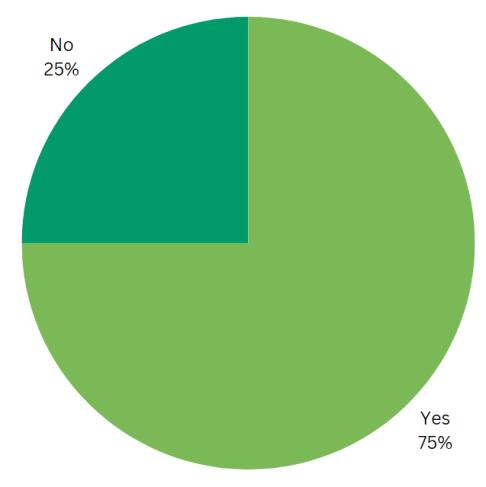
Page 18 of 29

“Yes,butitwillhaveits challengesfromafamily friendlyperspective.”
“Iwould,butIalways recommendthattheyconsider doingsaynursingfirsttogive themoptionsforlifeafter ambulance”
“Despitetherebeingalackofgoodfemale leaders,Idobelieveitwillimproveandit reallyisawonderfuljob.Tocontributetoa purposelikecaringforthecommunityintheir hardestmomentsisaveryworthwhilecareer.”
“Therosteringsystemneeds anoverhaulbeforeIwould recommendtoanyone.”
“Iwouldrecommenddualqualificationin nursingsothatifrequiredtheycanworkin nursingasitissomuchmoreflexibleand familyfriendly.Ambulanceistrying,butIthink wehavealongwaytogo.”
Please share any other thoughts or feelings you have below
“IhopemoreWomenareabletotake onleadershiprolesandnotmissout becausetheyhaveafamily.Iwouldlike toseeachangethatacknowledges familylifeandthatbothfemaleand maleparentsareequallyrequiredto makeafamilyandjobsshouldreflect equalopportunitytoallgenders.”
“Theoperationaldutiesofaparamedicarethesame forbothmaleandfemale.Thedisparityhoweveris thebiaspreventingequalopportunityforcareer developmentthatistargetedatwomenbecauseof perceivedbarrierssurroundingparental responsibilitiesandtheabilitytofulfillworkplace commitments.”
“Iamanon-roadparamedicthathascontinuedtostudy whilstworkingfulltimetryandimprovemyskillswhichwill hopefullyleadtofurthercareeropportunities.Iamalso singleandhavenothadchildren.SometimesIfindithardto seehowIwillbeabletoadvancewhenIobservepeople movingintooffroadrolesduetocertainconditions(whichI amnotdisputingandit’sunderstandable)andthenan expressionofinterest(EOI)formorepermanentor leadershiprolesinthatdepartmentcomeup.Thepeoplewho hadbeen'given'thoseplacements (althoughstill operational),oftengetofferedtheEOIiftheydecidetoapply duetohaving'previousexperience'. I'mnotsurehowIcan evercompetewiththisprocess.”
“Iunderstandthatchangecannotbeachieved overnight.However,improvingthecultureinthe organisationwillinitiatechangeandcreatea betterenvironmentthatwilltranslatetoeveryone intheworkforce,andnotjustwomen.”
“It'safabulousjob,anditIS whatyoumakeofit.I'd absolutelyencouragewomento takeupopportunitiestotry somethingdifferentandbe developed.Womenneedtobe abletonetworkandseeother womenwhoaresuccessful leadersbeingauthenticintheir roleANDsharingtheir skills/strategiesforsuccess.”
“Genderequalityhasalongwaytogoand accesstoappropriatechildcareandjob sharingwouldencouragemorewomenin leadershiprolesandtoworkmorein general.”
Page 19 of 29

Case Studies
Queensland Department of Education
Why is the Department of Education committed to be a family friendly workplace?
The Queensland Department of Education fosters an inclusive and high-performing workplace culture that responds to current and future education needs to ensure every student succeeds. Valuing and embracing the different skills, knowledge and experiences each of our staff brings is our approach to inclusion and diversity. We are uniquely positioned, with over 1,200 state schools spanning 7 regions and more than 84,000 employees. Approximately 95 percent of our workforce are in front-line roles.
Retaining and supporting staff who are parents and carers, through greater participation and access to career progression, is a significant driver for gender equality. This is vital to delivering inclusive educational services, as students form gender stereotypes based on their observation of role models, including within the school environment. Students who feel they belong, are understood, and those who have role models like them, have the best chance of succeeding.
Point of Difference
Share a family friendly workplace initiative that your organisation excels with and the impact it is having on the workplace culture.
The Flexible by Design Framework, launched in December 2020, sets out a vision for every one of our people to have an opportunity to experience a healthy work-life blend, enhancing their wellbeing and performance, leading to better service outcomes: giving all children a great start, engaging young people in learning, creating safe and inclusive workplaces, and building Queensland’s communities.
The COVID-19 health pandemic directly impacted the workforce when remote working and learning was temporarily implemented. Longer lasting impacts will be evident in new ways of working to ensure we adapt to changing contexts now and in the future. The response to the pandemic has reconfirmed the critical role that our people have in the community and the ability of our workplaces to adapt to evolving environments and improve service delivery.
Flexible work is a strategic tool for us to deliver high-quality service by attracting and retaining capable people and enabling career and service delivery continuity. In an evolving global environment, it is essential our department becomes increasingly adaptable, innovative and responsive.
The framework has flexible work conversations at its core in order to align individual needs with role requirements, service delivery outcomes and team priorities. This approach optimises overall performance and results. Due to the differing needs of employees and role requirements, there is a case-by-case approach. A proactive, open and collaborative approach supports our workforce to continue delivering high-quality service. Conversations might include options such as part-time work, job sharing, telecommuting, compressed and flexible accrued hours, purchased leave, or deferred salary scheme.
Page 20 of 29

How have you seen your people respond to this initiative?
Some schools and workplaces have been proactively implementing flexible work and are already realising the benefits. Job sharing is an example of how flexible work is being successfully implemented. Job sharing involves the sharing of duties and responsibilities of one position between 2 or more employees with arrangements flexibly tailored to suit a variety of circumstances, for example 2 x 0.5 positions, or a 0.3 and a 0.7 position. Job sharing across school-based roles is benefitting staff, students and schools – by increasing teaching knowledge and experience in the classroom or in leadership roles (2 heads are better than one), providing opportunity for upward mobility on a part-time basis (e.g. when a principal, deputy or Head of Department job shares with a classroom teacher), retaining valued teachers and leaders as they transition to retirement, and enabling teachers to return from parental leave on a part-time basis. Successful job-sharing partnerships are also providing benefits to staff and their families.
Secondary teachers in successful job-sharing arrangements have shared that having the option of flexible work is transformative for them as teachers, but also for their families too. The benefits include time with their children and having the work life balance to do both jobs (at home and at school) to the best of their ability, without feeling like one is lacking.
Job sharing offers an exceptional opportunity to mentor staff in higher duties, providing them with an authentic and enduring leadership experience that benefits the school, the staff and the students. Through offering staff development and mentoring opportunities, job sharing supports continuity in leadership and school culture. Job sharers also note that an important factor in teacher retention is leaders who proactively create a flexible work culture.
What are some of the business benefits you see from being a family inclusive organisation?
Creating inclusive workplace cultures is important to support a diverse workforce that represents the communities we serve. With the ongoing focus on attraction and retention of employees, our department must continue to position itself as an inclusive employer of choice. Being family inclusive is a key strategy to attract capable and agile people, retain valuable teaching staff, and support service delivery continuity and improvement.
https://familyfriendlyworkplaces.com/case_studies/flexible-by-design-at-the-queensland-department-ofeducation/
Page 21 of 29

Novartis Australia and New Zealand
Why is your organisation committed to be a family friendly workplace? What motivated your organisation to act on improving work & family outcomes in your workplace?
We were excited when we heard about the family friendly workplaces initiative because we saw it as a way to take another step in our quest to have the highest standards possible to support inclusivity in the workplace. As an organisation with a very long-standing and active Diversity and Inclusion Council, we have great foundations to build from – but we also wanted to ensure that we kept up with the pace of change.
What makes Novartis family friendly? What family inclusive programs, practices and processes does your organisation currently have in place?
Parental leave policy
In 2019 we rolled out an ungraded Parental leave policy, and we are proud to offer a minimum 14 weeks paid parental leave to our associates. Our policy also doesn’t differentiate – it is applicable to either parent following the birth, surrogacy or adoption of a child, effective from their first day of employment.
Equal pay
We have also made an EPIC Pledge committing to equal pay for women and men for work of equal value by 2023. Part of that commitment is to provide transparency to associates around internal and external benchmarking of their role.
Support for parents
Since 2019, parents planning or taking parental leave, and returning to work have access to coaching sessions from Parents At Work, to help make the transition successful.
We have had a long-term relationship with Benestar who deliver our Employee Assistance Program, and in 2020 we rolled out bespoke sessions with a psychologist to help people cope with the pandemic, including sessions to support wellbeing, juggling kids and work responsibilities, and staying healthy while working from home.
Pre-pandemic we ran a popular School Holiday Program for parents with school aged children based in our head office. We hope to bring this back as soon as we can.
Page 22 of 29

Flexible working
Novartis has also responded to our peoples’ desire for more flexibility by re-imagining how, when and where we work. Our global initiative called “Choice with Responsibility” seeks to move our organisation from a traditional model to a ‘distributed working’ model, leaving set working hours and locations behind.
In July 2020 we introduced an updated flexibility policy that applies to all office-based associates. The policy shifts responsibility from manager-approved to manager-informed, empowering associates to make decisions about how, when and where they work.
We also offered a one-off allowance to financially assist all previous office-based associates with working remotely towards the cost of equipment that supports a healthy and comfortable at-home work environment.
In 2021 we have been trialling co-working sites in the Sydney and Melbourne CBDs in addition to our Macquarie Park offices, as well as working from home options.
We estimate that more than 90 per cent of our associates work flexibly in one way or another.
Family inclusive initiatives
Wherever possible we consider our families when making resources available, for example enabling access to our Employee Assistance Program for family members. We also have other initiatives, such as allowing free access to Coursera for friends and family, and a program that allows our people to access healthcare advice as well.
How have the above impacted your workplace culture and productivity? How have your people responded?
• We have seen an increase in fathers accessing parental leave
• We’ve seen development opportunities for other associates open up (we can second others internally into backfill roles, which means people move around)
• Retention rates have improved, not just for parents taking parental leave and returning to flexible working arrangements, but others internally because of the increase in opportunities
• Our culture survey consistently shows high engagement
What we are implementing as a result of our participation in the FFW initiative:
• We are broadening our definitions, extending some of the benefits and explicitly calling out areas that needed inclusion such as the case of including personal leave for miscarriage and early pregnancy loss into our policy.
• We are also extending more education to our people leaders on our parental leave policies and programs and the role they play in this, both via on-boarding and ongoing.
• A new Domestic Violence policy is in process and will be introduced imminently to close this gap.
https://familyfriendlyworkplaces.com/case_studies/novartis-australia-our-greatest-strength-is-our-people/
Page 23 of 29

2022 Women in Ambulance Survey questionnaire
Thank you for taking part in our Women in Ambulance Survey. Our goal is to hear from women directly on the challenges, opportunities, and skills you believe are most critical in your career. We believe in the importance of providing women with a platform to give their voices to this topic directly, and to share their experiences and needs first-hand.
Q1: Please select the service you are from
• ACT Ambulance
• Ambulance Tasmania
• Ambulance Victoria
• NSW Ambulance
• Queensland Ambulance Service
• SA Ambulance Service
A few questions about you
Q2: How old are you?
• <29
• 30-39
• 40-49
Q3: What is your level of education?
• Associate Degree
• Advanced Diploma
• Bachelor Degree
• Bachelor Honours
• Certificate Level 1-4
• Diploma
Q4 What is your current length of service?
• <1 year
• 1-5 years
• 6-10 years
• 11-15 years
• St John Ambulance (NT)
• St John Ambulance WA
• St John New Zealand
• St John Papua New Guinea
• Wellington Free Ambulance
• 50-59
• 60+
• Doctoral Degree
• Graduate Certificate
• Graduate Diploma
• Masters Degree
• Tertiary Education
Q5 What is your current position in your organisation?
• Administrator
• Clinical Operations Personnel
• Communication Officer (EMD, Call taker, Dispatcher)
• Executive
• Finance and Corporate Services Personnel (IT, Infrastructure, Strategy)
• Manager
• 16-20 years
• 21-25 years
• 25+ years
• Paramedic
• People and Culture Personnel
• Senior Manager
• Student/Intern
• Supervisor
• Team Leader
• Volunteer
• Other (Please specify)
Page 26 of 29
Q6 What is your employment type?
• Casual
• Full-time
• Part-time
Thinking about leadership
Q7 What does leadership mean to you?
Open ended response

• Volunteer
• Flexible Full-Time
• Flexible Part-Time
Q8 Which skills do you value most in a leader? (Please select all answers that apply)
• Accountability
• Commitment
• Communication
• Creativity
• Delegation
• Empathy
Thinking about leadership and you
• Feedback
• Flexibility
• Motivation
• Positivity
• Responsibility
• Trustworthiness
Q9 Independent of my job title, I am a leader in my organisation
• Strongly agree
• Agree
• Neither agree nor disagree
• Disagree
• Strongly disagree
Q10 I actively pursue learning and professional growth opportunities
• Strongly agree
• Agree
• Neither agree nor disagree
• Disagree
• Strongly disagree
Q11 How do you pursue your learning and professional growth? (Please select all answers that apply)
• Education
• Networking
• Research
Q12 I am comfortable exercising my own authority
• Strongly agree
• Agree
• Neither agree nor disagree
• Peer Coaching
• Mentoring
• Other (please specify)
• Disagree
• Strongly disagree
Q13 On a personal level, do you feel confident that you can advance to more senior levels of leadership?
• Strongly agree
• Agree
• Neither agree nor disagree
• Disagree
• Strongly disagree
Page 27 of 29

Q14 What are the biggest challenges faces when pursuing your career goals?
• Age
• Confidence
• Dealing with unconscious (or conscious) bias
• Emotional or physical burden
• Having opportunities for promotion
• Limited access or expense of childcare
Thinking about leadership and your organisation
• Limited access to networks of women
• Location of opportunity
• Minimal female role models
• Parental or other carer responsibilities
• Qualifications
• Self-doubt
• Other (please specify)
Q15 What are the current leadership development opportunities in your organisation?
• Internal Course
• Leadership development program
• Scholarship
• Sponsorship of Study
• Other (please specify)
Q16 What would you like to see in the way of leadership development opportunities in your organisation?
• Internal course
• Leadership development program
• Scholarship
• Sponsorship of study
• Other (please specify)
Q17 What in your opinion impedes leadership development training?
Open ended response
Q18 Does your organisation recognise and reward leadership?
• Strongly agree
• Agree
• Neither agree nor disagree
Thinking about the last job application you saw
• Disagree
• Strongly disagree
Q19 Have you applied for a leadership position in the last 12 months?
• Yes
• No
Q20 Can you share the process and any thoughts or feelings of your latest application
Open ended response
Q21 Can you share any thoughts or feelings as to what stopped you from applying for the position?
Open ended response
Q22 What changes would you like to see in 5-10 years that isn't currently in place?
Open ended response
Q23 Would you recommend a career in the ambulance sector to other females?
• Yes
• No
Q24 Please share any other thoughts or feelings you have below
Open ended response
Page 28 of 29
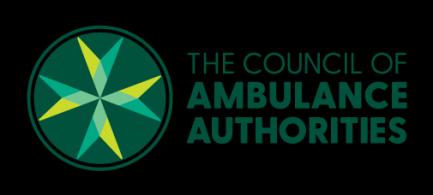
Produced in February 2023
The Council of Ambulance Authorities Inc.
2/141 Sir Donald Bradman Drive Hilton SA 5033
www.caa.net.au

Page 29 of 29


